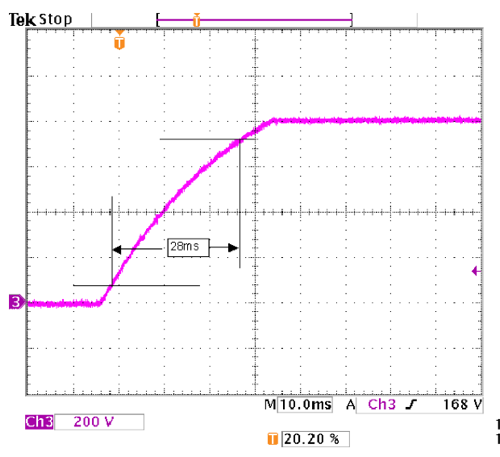The slew rate of a DC power supply is the rate at which the output voltage and output current changes. This characteristic is important in many applications, especially automatic test applications, as the faster a supply reaches a programmed voltage or current, the faster a test will run.
The voltage slew rate is mostly independent of the connected device under tests (DUT). Rather, it's a function of the supply filter capacitors. To improve ripple and noise specifications, the output filters of DC programmable power supplies use large capacitors that store a lot of energy. It’s mainly the charge and discharge time of this filter that determines a supply’s voltage slew rate.
The DC output rise time for most AMETEK supplies is sufficiently fast for most applications. The Sorensen SG Series, for example, has a typical rise time (5-95% full scale) of less than 100 ms, and often much less. As shown in the screenshot below, the risetime for this SG800 power supply is only 28 ms.

The DC output fall time can be more problematic. The fall time depends not only on the power supply's filter circuit characteristics, but also on the DUT. If the DUT is drawing relatively little current compared with the power supply current capacity, it can take many seconds before the energy stored in the output capacitors “leaks” away through the DUT.
On the other hand, if the DUT is drawing 60% or more of the power supply capability, the DUT will dissipate the stored energy nearly instantaneously and the output voltage fall-time will be quite short. Nevertheless, in most cases the DC output fall-time will be two to three times slower then the DC output rise time.
One way to improve the DC output rise time is to choose a programmable power supply with a maximum DC voltage output that's higher than what you need. For example, when testing automotive devices, you wouldn't normally choose a supply with a maximum output voltage that's greater than 30 V.
If rise time was an issue, however, you might want to choose a programmable power supply with a maximum output voltage of 60 V, but only use it up to 30VDC. The reason for this is that the output capacitor for the 60 VDC supply will be much smaller than the output capacitor for the 30 VDC programmable supply to allow the voltage to rise from 0 V to full scale in the same amount of time for both supplies. As a result, the output voltage will rise from 0 V to 30 V faster, when the power supply has a maximum output voltage of 60 V than when the maximum output voltage is only 30 V.
To improve DC output fall-time, connect a “pre-load” in parallel with the DUT. To obtain the shortest fall time, size the pre-load so that the total current demand is at least 65% of the programmable power supply’s current capability. The downside of this approach is that you'll need a bigger power supply, but it will allow you to meet the DC fall-time requirements of your test.




